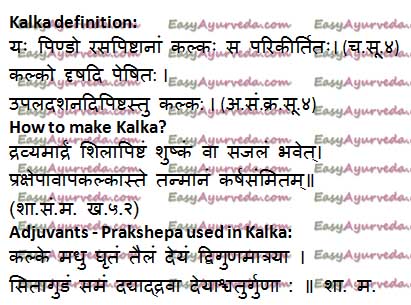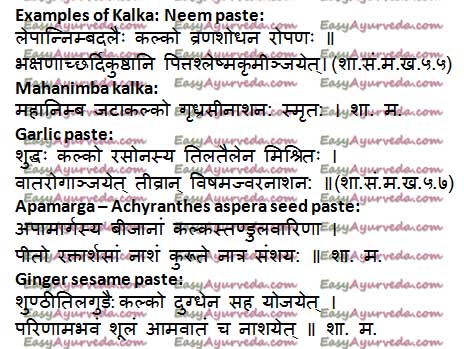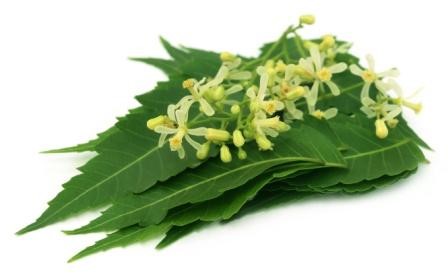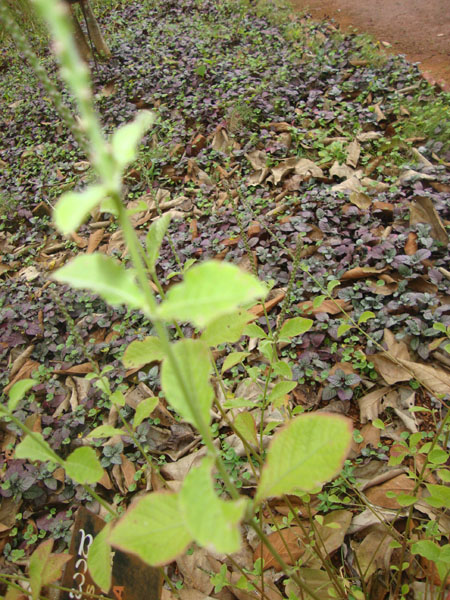Kalka Kalpana (Ayurvedic Herbal Pastes) Uses, Preparation, Examples
Herbal pastes are called Kalka in Ayurveda. Kalka is one among the five basic dosage forms. The other four are – juice extract, decoction, cold and hot infusions. In Ayurveda, herbal pastes are used both for internal and external use.
Table of Contents
Kalka definition
Definition of Kalka:
The Pinda – bolus or paste prepared from fresh herbs, which is rasapishta – has some liquidity in it, is considered as Kalka.
The wet or dry herb is ground as it is or by adding water, it can be added with other adjuvants and administered.
So, Kalka can be prepared either with fresh herbs or with dry herbs.
यः पिण्डो रसपिष्टानां कल्कः स परिकीर्तितः । (च.सू.४)
The Pinda – bolus or paste prepared from fresh herbs, which is rasapishta – has some liquidity in it, is considered as Kalka. Charaka Samhita Sutrasthana 4th chapter
कल्को दृषदि पेषित: ।
उपलदशनदिपिष्टस्तु कल्क: । (अ.सं..सू.४)
Fresh herbs are ground in mortar and pestle to prepare Kalka.
Ashtanga Sangraha, Sutrasthana 4th chapter
Sanskrit Shlokas

Dose, Adjuvants (Prakshepa)
Dose – 1 karsha – 12 grams once or twice per day.
Adjuvants – Prakshepa for herbal pastes:
कल्के मधु घृतं तैलं देयं द्विगुणमात्रया ।
सितागुडं समं दद्याद्द्रवा देयाश्चतुर्गुणा : ॥ शा. म.
Sharangdhara Samhita Madhyama Khanda 5
Honey, ghee, sesame oil – if at all are indicated along with any kalka, it should be mixed in double quantity to that of Kalka.
Eg: 5 grams of neem paste, administered along with 10 grams of ghee.
Sugar candy or jaggery – is mixed in equal quantities.
Any liquid (kashaya, juice extract etc) is added 4 times the dose of kalka.
- Honey, ghee, sesame oil – if at all are indicated along with any kalka, it should be mixed in double quantity to that of Kalka.
- Eg: 5 grams of neem paste, administered along with 10 grams of ghee.
- Sugar candy or jaggery – is mixed in equal quantities.
- Any liquid (kashaya, juice extract etc) is added 4 times the dose of kalka.
Kalka examples


Examples of herbal pastes:
Neem paste
It is applied externally to cleanse and heal wound faster.
It is administered internally to treat vomiting, skin disorders, intestinal parasites and Pitta and Kapha disorders.
Mahanimba – Melia azadirach
Mahanimba kalka is administered to treat sciatica.
Garlic Paste
शुद्धः कल्को रसोनस्य तिलतैलेन मिश्रितः ।
वातरोगाञ्जयेत् तीव्रान् विषमज्वरनाशन: ॥Sharangdhara Samhita Madhyama Khanda 5/7
De-skinned garlic pearls are made into paste. Administered along with sesame oil. It is administered in Vata disorders and in Vishamajwara – Recurrent fever.

Apamarga paste
Apamarga Kalka – Achyranthes aspera paste:
Apamarga – Achyranthes aspera seed paste is administered along with rice washed water.
Useful in Raktarsha – bleeding hemorrhoids.
Ginger paste
Ginger- sesame-jaggery paste:
Paste made of ginger, sesame seed and jaggery is administered along with cow milk to treat peptic ulcers and rheumatoid arthritis.
Uses of Kalka
Pastes are used for external application.
They are used for oral administration.
They are used for application over oral ulcers
They are used as mild suppositories
They are applied over wounds.
They are used in the preparation of herbal ghees, herbal oils, herbal decoctions (called Pramathya), etc.










2 comments
Chandrsashekahr N Kane
What is the best Ayurvedic Upchar against Amlapitta ?
Dr J V Hebbar MD(Ayu)Author
There are many remedies. Please read here
https://www.easyayurveda.com/2013/09/26/fruitful-ayurvedic-remedies-for-gastritis/